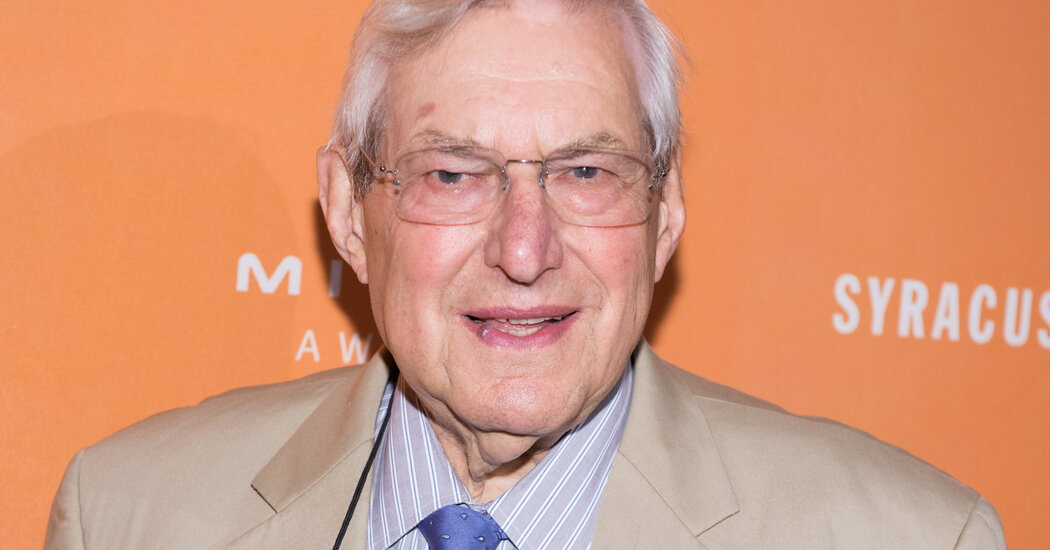
Seeing untold promise in new technology, he was a prime mover in the creation of the cable industry, helping to transform Time Warner Cable into a giant in the field.
Edward Bleier, who brought Bugs Bunny, Porky Pig and other Looney Tunes characters to generations of Saturday morning TV viewers before becoming a prime mover in the rise of cable television and the transformation of Time Warner Cable into an industry giant, died on Tuesday at his home in East Hampton, N.Y. He turned 94 the day before.
His death was confirmed by his wife, Magda Bleier.
A former journalist who began his career in newspapers and radio, Mr. Bleier was an innovator who foresaw industry-changing technologies and the need for fresh content to serve the emerging cable television market. At ABC and later at Warner Bros. Television, he gained a reputation for imaginative but also practical strategic thinking that helped usher in a new television era.
From 1986 to 2000, he was president of a Warner Bros. division that developed basic cable networks such as Nickelodeon, MTV and The Movie Channel. He was credited with achieving record-breaking sales of vintage movies and older television series, shown in reruns, annually surpassing the income those productions had earned when first released.
As far back as 1961, while at ABC, Mr. Bleier saw a future for vintage Looney Tunes cartoons, animated shorts made by Warner Bros. and shown in movie theaters in the 1930s and ’40s. He licensed them and then repackaged them as Saturday morning TV viewing for children. The move transformed Looney Tunes and similar cartoons into consistent profit-makers for both ABC and Warner Bros.
Later, as president of Warner Bros. Animation, he created dozens of variations of Looney Tunes programming for cable and broadcast networks, along with movies and television specials featuring the cartoon characters.
“My instinct was always to look ahead, not back,” Mr. Bleier said in an interview for this obituary in 2015. “I saw radio coming on, so I moved from newspapers. I saw television coming on, and I couldn’t get in it fast enough.”
He joined ABC in the early 1950s and spent the next 14 years at the network. While he believed that the medium could be used for social good, he also understood that commercial television had to reach the largest possible audience and earn a profit.
“I perceived the media not in self-conscious terms of ‘do-good,’ but as important in the social fabric,” he said. “You only had so many hours in the day, so I focused on those things that did good while doing well.”
Mr. Bleier was head of ABC’s daytime programming in 1964 when civil rights advocates, including Harry Belafonte, criticized an absence of Black actors in the network’s popular soap operas. ABC soon began integrating its daytime lineup.
“We knew that maybe 30 percent of the audience for the soaps were Black women,” he recalled, “so this worked not only socially but economically.”
Mr. Bleier’s biggest contributions came at Warner Bros. Answering a call from Steven J. Ross, the New York parking lot magnate who bought Warner Brothers studio in 1969, Mr. Bleier signed on to run the New York programming and sales office. As Mr. Ross built the company, Mr. Bleier became a trusted adviser, shaping the strategy for taking the company into cable television and new digital media.
He helped guide the company into partnerships with American Express and later Time Inc. In 1990, Warner Cable became Time Warner Cable. (It was acquired by Charter Communications in 2016, becoming the nation’s second-largest cable operator, after Comcast.) Until he retired from Time Warner in 2005, Mr. Bleier continued to explore new digital media markets, including one for on-demand content delivered through the internet. Even into his 80s he continued to consult with the company.
“Ed was there at that birthing” of the cable industry, Leo Hindery, a media entrepreneur and former president and chief executive of AT&T Broadband, said in an interview. “This is an industry of giant egos, but Ed had none. He was one of the true pioneers.”
Edward Bleier was born in New York City on Oct. 16, 1929, to Philip and Cecile (Richter) Bleier. His family lived in a small apartment off the Grand Concourse in the Bronx before moving to the Laurelton section of Queens, where he grew up. His father, a son of Viennese immigrants, trained as a lawyer but became an insurance broker. His mother, a homemaker, had immigrated from Belarus.
Edward, who attended public schools, had his first taste of journalism as a high school stringer for city newspapers, including The New York Times.
In 1947, he enrolled at Syracuse University as a radio major. There, he joined the campus radio station and worked on a program written by William Safire, the future Times columnist, with Dick Clark, the future pop music TV host, as the announcer.
Mr. Bleier and Mr. Safire became lifelong friends. Mr. Bleier introduced him to Helene Belmar Julius, a model, pianist and jewelry designer who would become Mr. Safire’s wife. Mr. Safire later returned the favor, introducing Mr. Bleier to Magda Palacci, a French-language journalist who became the bureau chief for Paris Match in New York. They married in 1973. She is his only survivor.
In the summer of 1949, Mr. Bleier and Mr. Safire, working in New York, made the joint decision to drop out of college. “We’d meet for lunch several times a week and look at each other and ask, ‘Why go back? We have the jobs we were going there to get,’” Mr. Bleier recalled. He returned to Syracuse in 1994 and earned his degree.
Mr. Bleier began his TV career at Channel 5 in New York, a station owned by the DuMont Television Network. From there he moved to ABC, where his work in strategic planning helped him recognize the coming impact of cable television. Frustrated with what he saw as a lack of vision at ABC, he left in 1968 to “go into the program business to fill these new channels,” he said.
After joining Warner Bros., he worked closely with Gustave Hauser, who built the innovative cable system QUBE for Warner Bros. In 1977, QUBE, based in Columbus, Ohio, introduced pay-per-view programs, special-interest cable networks and interactive services.
“We had to build things Ed knew a lot about,” Mr. Hauser, who died in 2021, said in an interview in 2015. “We were starting something very new, a first effort to do pay TV. It was the beginning of the modern cable business, and Ed loved it.”
For Mr. Bleier, QUBE’s success underscored his philosophy about a coming wave of change. “We had the approach that software drove the hardware,” he said, “and I took a McLuhanesque approach — that although content is king, form is emperor. Technology determines the content.”
Running the Warner Bros. division responsible for licensing old movies and television shows to cable and broadcast outlets, Mr. Bleier worked with a growing list of start-up cable and pay-TV outlets, including HBO. As a member of Mr. Ross’s strategy committee, he gained widespread industry influence, representing the company in a period of rapid growth and innovation.
As president of Warner Bros. Animation and knowing of Steven Spielberg’s deep affection for Looney Tunes characters, he also collaborated with the director on three animated series, including “Steven Spielberg Presents Tiny Toon Adventures.”
In a departure from television in 2003, Mr. Bleier produced a best-selling book, “The Thanksgiving Ceremony: New Traditions for America’s Family Feast,” a paean to his favorite holiday, with a foreword by Mr. Safire. “My attitude is that everything embodied in this country is in that holiday and should be celebrated accordingly,” Mr. Bleier said.
He remained devoted to Syracuse University. In 2005, its Center for the Study of Popular Television, part of the S.I. Newhouse School of Public Communications, was renamed the Bleier Center for Television and Popular Culture thanks to a large donation from Mr. Bleier.
In addition to East Hampton, he had a home on the Upper East Side of Manhattan.
In an interview, Mr. Bleier attributed his success to “feeling as though you are doing the right thing, being skillful, delivering, not getting lost in idealism, staying very practical and very quantitative but looking ahead, not backwards.”
He said he was guided not so much by the management theorist Peter Drucker as by John Maynard Keynes, who overturned conventional thinking in economics.
“I don’t quote Drucker,” Mr. Bleier said, “I quote Keynes: The difficulty lies not so much in developing new ideas as in escaping from old ones.”
Alex Traub contributed reporting.




